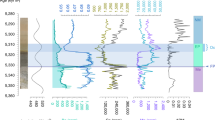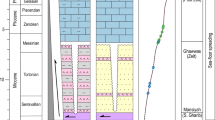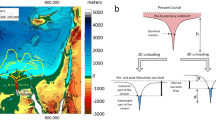Abstract
PROBABLY the most profound event that has affected the Mediter-ranean is the desiccation which occurred at the end of the Miocene1–8. During this period, there was a very rapid change from deep, open-marine conditions to environments of shallow-water carbonate and massive evaporite deposition1–10. Here we show that ostracod valves found in Messinian Lago Mare (Lake Sea) sediments, have a uniform but generally lower Sr isotopic composition than contemporary sea water thus providing evidence that some of the major Mediterranean basins (for example, Balearic and Levantine basins) formed large lacustrine systems that were probably interconnected towards the end of the Messinian salinity crisis1–3 after the major evaporites were deposited. The most likely source of fresh water is from continental rivers flowing from the eastern European inland Paratethys sea or perhaps the Nile River. In the lower part of the Lago Mare, some ostracods have Sr isotopic compositions identical to contemporary sea water indicating a transient influence of marine-derived water. Sr compo-sitions greater than that in contemporary sea water are only found in ostracods from onshore sediments in the Sorbas Basin4,5 of southeastern Spain suggesting that this small basin, adjacent to the Straits of Gibraltar, became isolated after the deposition of the major evaporite sequences.
This is a preview of subscription content, access via your institution
Access options
Subscribe to this journal
Receive 51 print issues and online access
$199.00 per year
only $3.90 per issue
Buy this article
- Purchase on SpringerLink
- Instant access to full article PDF
Prices may be subject to local taxes which are calculated during checkout
Similar content being viewed by others
References
Hsü, K. J. et al. Nature 267, 399–403 (1977).
Hsü, K. J. et al. Init. Rep. DSDP Leg 42, 219–304 (1978).
Melières, F., Chamky, H., Coumes, F. & Rouge, P. Init. Rep. DSDP Leg 42, 361–384 (1978).
Roep, T. B. & van Harten, D. Annls Géol. Pays Hell. Tome hors serie III, 1037–1044 (1979).
Dronkert, H. Memorie Soc. geol. ital. 16, 341–361 (1976).
Cita, M. B., Wright, R. C., Ryan, W. B. F. & Longinelli, A. Init. Rep. DSDP Leg 42, 1003–1035 (1978).
Drooger, C. W. (ed.) Messinian Events in the Mediterranean (North Holland, Amsterdam, 1973).
Hsü, K. J. et al. Init. Rep. DSDP Leg 42, 1–1249 (1978).
McKenzie, J. A. & Ricchiuto, T. E. Init. Rep. DSDP Leg 42, 650–655 (1978).
Pierre, C. & Fontes, J. C. Init. Rep. DSDP Leg 42, 635–650 (1978).
Ruggieri, G. Publs Syst. Ass. 7, 283–290 (1967).
McCulloch, M. T., De Deckker, P. & Chivas, A. R. Geochim. cosmochim. Acta. 53, 1703–1710 (1989).
DePaolo, D. J. & Ingram, B. L. Science 227, 938–941 (1985).
Palmer, M. R. & Elderfield, H. Nature 314, 526–528 (1985).
Koepnick, R. B. et al. Chem. Geol. 58, 55–81 (1985).
Elderfield, H. Palaeogeogr. Palaeoclimatol. Palaeoecol. 57, 71–90 (1986).
Mulder, C. J. Messinian Events in the Mediterranean (ed. Drooger, C. W.) 44–59 (North Holland, Amsterdam, 1973).
Weijermars, R. Tectonophysics 148, 211–219 (1988).
De Deckker, P., Colin, J. P. & Peypouquet, J. P. (eds) Ostracoda in the Earth Sciences (Elsevier, Amsterdam, 1988).
De Deckker, P. Palaeogeogr. Palaeoclimatol. Palaeoecol. 62, 463–475 (1988).
Turpen, J. B. & Angell, R. W. Biol. Bull. 140, 331–338 (1971).
Chivas, A. R., De Deckker, P. & Shelley, J. M. G. Hydrobiologia 143, 135–142 (1986).
De Deckker, P. Hydrobiologia 81, 131–144 (1981).
McKenzie, J. A., Hodell, D. A., Mueller, P. A. & Mueller, D. W. Geology 16, 1022–1025 (1988).
De Deckker, P., Chivas, A. R. & Shelley, J. M. G. Palaios 3, 352–358 (1988).
Rouchy, J. M. Bull. Centre Rech. Expl Elf-Aquit. 4, 511–545 (1980).
Müller, D. W. & Hsü, K. J. Paleoceanography 2, 679–696 (1987).
Hsü, K. J. Scient. Am. May 53–63 (1978).
Dietz, R. S. & Woodhouse, M. Geotimes 43, 4 (1988).
Brass, G. W. Geochim. cosmochim. Acta 40, 721–730 (1976).
Palmer M. R. & Edmond J. M. Earth planet. Sci. Lett. 92, 11–26 (1989).
Eugster, H. P. & Hardie, L. A. in Saline Lakes (ed. Lerman, A.) 237–294 (Springer, Berlin, 1978).
Anadon, P., De Deckker, P. & Julia, R. Hydrobiologia 143, 199–208 (1986).
Author information
Authors and Affiliations
Rights and permissions
About this article
Cite this article
McCulloch, M., Deckker, P. Sr isotope constraints on the Mediterranean environment at the end of the Messinian salinity crisis. Nature 342, 62–65 (1989). https://doi.org/10.1038/342062a0
Received:
Accepted:
Issue date:
DOI: https://doi.org/10.1038/342062a0
This article is cited by
-
50th anniversary review of the Mediterranean desiccation hypothesis
La Rivista del Nuovo Cimento (2023)
-
An experimental evaluation of cleaning methods for fossil ostracod Mg/Ca and Sr/Ca determination
Journal of Paleolimnology (2006)
-
Chronology, causes and progression of the Messinian salinity crisis
Nature (1999)
-
Trace-element and stable-isotope geochemistry of non-marine ostracod shells in Quaternary palaeoenvironmental reconstruction
Journal of Paleolimnology (1996)
-
Mediterranean Messinian (Miocene) and other evaporites: Introduction
Carbonates and Evaporites (1991)



